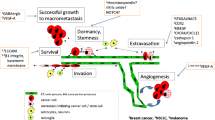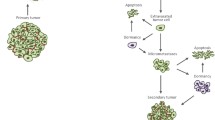Abstract
The incidence of brain metastasis is increasing, however, little is known about the molecular mechanisms responsible for metastasis of peripheral tumor cells and their colonization of the brain. After tumor cells metastasize to the brain, they encounter a completely different microenvironment from that in the periphery. The interactions between tumor cells and glial cells, mainly astrocytes and microglia, including soluble factors released from these cells, are still under investigation. However this knowledge will contribute to understanding the mechanisms of cell-cell interactions in the brain and identify possible therapeutic targets on resident brain cells that could effect brain metastasis formation and treatment. In addition to the complex interactions between metastatic tumor cells and the brain’s resident cells, factors from endothelial cells and endogenous plasma factors also affect the blood-brain barrier and may change tumor cell characteristics. Therefore the totality of the brain microenvironment must be considered. The cell types and soluble factors that contribute to the brain microenvironment surrounding metastatic tumor cells are discussed herein.
Access this chapter
Tax calculation will be finalised at checkout
Purchases are for personal use only
Similar content being viewed by others
References
Fidler IJ, Yano S, Zhang RD et al (2002) The seed and soil hypothesis: vascularisation and brain metastases. Lancet Oncol 3(1):53–57
Aloisi F, Ria F, Adorini L (2000) Regulation of T-cell responses by CNS antigen-presenting cells: different roles for microglia and astrocytes. Immunol Today 21(3):141–147
Balkwill F, Mantovani A (2001) Inflammation and cancer: back to Virchow? Lancet 357(9255):539–545
Fitzgerald DP, Palmieri D, Hua E et al (2008) Reactive glia are recruited by highly proliferative brain metastases of breast cancer and promote tumor cell colonization. Clin Exp Metastasis 25(7):799–810
Lorger M (2012) Tumor microenvironment in the brain. Cancer 4(1):218–243
Heyn C, Ronald JA, Ramadan SS et al (2006) In vivo MRI of cancer cell fate at the single-cell level in a mouse model of breast cancer metastasis to the brain. Magn Reson Med 56(5):1001–1010
Farber K, Kettenmann H (2005) Physiology of microglial cells. Brain Res Brain Res Rev 48(2):133–143
Kim SU, de Vellis J (2005) Microglia in health and disease. J Neurosci Res 81(3):302–313
Kreutzberg GW. (1996) Microglia: a sensor for pathological events in the CNS. Trends Neurosci 19(8):312–318
Perry VH, Matyszak MK, Fearn S (1993) Altered antigen expression of microglia in the aged rodent CNS. Glia 7(1):60–67
Santambrogio L, Belyanskaya SL, Fischer FR et al (2001) Developmental plasticity of CNS microglia. Proc Natl Acad Sci USA 98(11):6295–6300
Morantz RA, Wood GW, Foster M et al (1979) Macrophages in experimental and human brain tumors. Part 2: studies of the macrophage content of human brain tumors. J Neurosurg 50(3):305–311
Kettenmann H, Hanisch UK, Noda M et al (2011) Physiology of microglia. Physiol Rev 91(2):461–553
Davalos D, Grutzendler J, Yang G et al (2005) ATP mediates rapid microglial response to local brain injury in vivo. Nat Neurosci 8(6):752–758
Nimmerjahn A, Kirchhoff F, Helmchen F (2005) Resting microglial cells are highly dynamic surveillants of brain parenchyma in vivo. Science 308(5726):1314–1318
Hanisch UK (2002) Microglia as a source and target of cytokines. Glia 40(2):140–155
Noda M, Seike T, Fujita K et al (2009) The role of immune cells in brain metastasis of lung cancer cells and neuron-tumor cell interaction. Ross Fiziol Zh Im I M Sechenova 95(12):1386–1396
Miller RH, Ffrench-Constant C, Raff MC (1989) The macroglial cells of the rat optic nerve. Annu Rev Neurosci 12:517–534
Seike T, Fujita K, Yamakawa Y et al (2011) Interaction between lung cancer cells and astrocytes via specific inflammatory cytokines in the microenvironment of brain metastasis. Clin Exp Metastasis 28(1):13–25
Zhang M, Olsson Y (1995) Reactions of astrocytes and microglial cells around hematogenous metastases of the human brain. Expression of endothelin-like immunoreactivity in reactive astrocytes and activation of microglial cells. J Neurol Sci 134(1–2):26–32
Kettenmann H, Ransom BR (2005) Neuroglia, Oxford University Press, Oxford
Kang SH, Fukaya M, Yang JK et al (2010) NG2+ CNS glial progenitors remain committed to the oligodendrocyte lineage in postnatal life and following neurodegeneration. Neuron 68(4):668–681
Winkler EA, Bell RD, Zlokovic BV (2010) Pericyte-specific expression of PDGF beta receptor in mouse models with normal and deficient PDGF beta receptor signaling. Mol Neurodegener 5:32
Dore-Duffy P, Cleary K (2011) Morphology and properties of pericytes. Methods Mol Biol 686:49–68
Krueger M, Bechmann I (2010) CNS pericytes: concepts, misconceptions, and a way out. Glia 58(1):1–10
Winkler EA, Bell RD, Zlokovic BV (2011) Central nervous system pericytes in health and disease. Nat Neurosci 14(11):1398–1405
Quaegebeur A, Segura I, Carmeliet P (2010) Pericytes: blood-brain barrier safeguards against neurodegeneration? Neuron 68(3):321–323
**an X, Hakansson J, Stahlberg A et al (2006) Pericytes limit tumor cell metastasis. J Clin Invest 116(3):642–651
Singh SK, Hawkins C, Clarke ID et al (2004) Identification of human brain tumour initiating cells. Nature 432(7015):396–401
Chu JE, Allan AL (2012) The role of cancer stem cells in the organ tropism of breast cancer metastasis: a mechanistic balance between the “seed” and the “soil”? Int J Breast Cancer 2012:209748
Calabrese C, Poppleton H, Kocak M et al (2007) A perivascular niche for brain tumor stem cells. Cancer Cell 11(1):69–82
Fitzgerald DP, Subramanian P, Deshpande M et al (2012) Opposing effects of pigment epithelium-derived factor on breast cancer cell versus neuronal survival: implication for brain metastasis and metastasis-induced brain damage. Cancer Res 72(1):144–153
Lorger M, Felding-Habermann B (2010) Capturing changes in the brain microenvironment during initial steps of breast cancer brain metastasis. Am J Pathol 176(6):2958–2971
Giavazzi R, Garofalo A, Bani MR et al (1990) Interleukin 1-induced augmentation of experimental metastases from a human melanoma in nude mice. Cancer Res 50(15):4771–4775
Vidal-Vanaclocha F, Alvarez A, Asumendi A et al (1996) Interleukin 1 (IL-1)-dependent melanoma hepatic metastasis in vivo; increased endothelial adherence by IL-1-induced mannose receptors and growth factor production in vitro. J Natl Cancer Inst 88(3–4):198–205
Vidal-Vanaclocha F, Amezaga C, Asumendi A et al (1994) Interleukin-1 receptor blockade reduces the number and size of murine B16 melanoma hepatic metastases. Cancer Res 54(10):2667–2672
Sierra A, Price JE, Garcia-Ramirez M et al (1997) Astrocyte-derived cytokines contribute to the metastatic brain specificity of breast cancer cells. Lab Invest 77(4):357–368
Marchetti D, Denkins Y, Reiland J et al (2003) Brain-metastatic melanoma: a neurotrophic perspective. Pathol Oncol Res 9(3):147–158
Denkins Y, Reiland J, Roy M et al (2004) Brain metastases in melanoma: roles of neurotrophins. Neuro Oncol 6(2):154–165
Aloisi F, Care A, Borsellino G et al (1992) Production of hemolymphopoietic cytokines (IL-6, IL-8, colony-stimulating factors) by normal human astrocytes in response to IL-1 beta and tumor necrosis factor-alpha. J Immunol 149(7):2358–2366
Hertz L, McFarlin DE, Waksman BH (1990) Astrocytes: auxiliary cells for immune responses in the central nervous system? Immunol Today 11(8):265–268
Lee SC, Liu W, Dickson DW et al (1993) Cytokine production by human fetal microglia and astrocytes. Differential induction by lipopolysaccharide and IL-1 beta. J Immunol 150(7):2659–2667
Wang FW, Jia DY, Du ZH et al (2009) Roles of activated astrocytes in bone marrow stromal cell proliferation and differentiation. Neuroscience 160(2):319–329
Kim SJ, Kim JS, Park ES et al (2011) Astrocytes upregulate survival genes in tumor cells and induce protection from chemotherapy. Neoplasia 13(3):286–298
Iravani MM, Sadeghian M, Leung CC et al (2012) Lipopolysaccharide-induced nigral inflammation leads to increased IL-1beta tissue content and expression of astrocytic glial cell line-derived neurotrophic factor. Neurosci Lett 510(2):138–142
Zhang H, Gu YT, Xue YX (2007) Bradykinin-induced blood-brain tumor barrier permeability increase is mediated by adenosine 5’-triphosphate-sensitive potassium channel. Brain Res 1144:33–41
Qin LJ, Gu YT, Zhang H et al (2009) Bradykinin-induced blood-tumor barrier opening is mediated by tumor necrosis factor-alpha. Neurosci Lett 450(2):172–175
Ma T, Liu L, Wang P et al (2012) Evidence for involvement of ROCK signaling in bradykinin-induced increase in murine blood-tumor barrier permeability. J Neurooncol 106(2):291–301
Montana V, Sontheimer H (2011) Bradykinin promotes the chemotactic invasion of primary brain tumors. J Neurosci 31(13):4858–4867
Palmieri D, Fitzgerald D, Shreeve SM et al (2009) Analyses of resected human brain metastases of breast cancer reveal the association between up-regulation of hexokinase 2 and poor prognosis. Mol Cancer Res 7(9):1438–1445
Park ES, Kim SJ, Kim SW et al (2011) Cross-species hybridization of microarrays for studying tumor transcriptome of brain metastasis. Proc Natl Acad Sci USA 108(42):17456–17461
Acknowledgment
This work was supported by Grants-in Aid for Scientific Research from the Japanese Society for Promotion of Science.
Author information
Authors and Affiliations
Corresponding author
Editor information
Editors and Affiliations
Rights and permissions
Copyright information
© 2012 Springer Science+Business Media Dordrecht
About this chapter
Cite this chapter
Noda, M. (2012). The Brain Microenvironment. In: Palmieri, D. (eds) Central Nervous System Metastasis, the Biological Basis and Clinical Considerations. Cancer Metastasis - Biology and Treatment, vol 18. Springer, Dordrecht. https://doi.org/10.1007/978-94-007-5291-7_3
Download citation
DOI: https://doi.org/10.1007/978-94-007-5291-7_3
Published:
Publisher Name: Springer, Dordrecht
Print ISBN: 978-94-007-5290-0
Online ISBN: 978-94-007-5291-7
eBook Packages: Biomedical and Life SciencesBiomedical and Life Sciences (R0)




